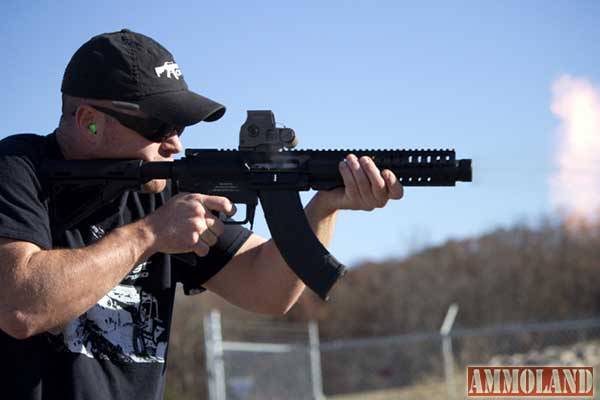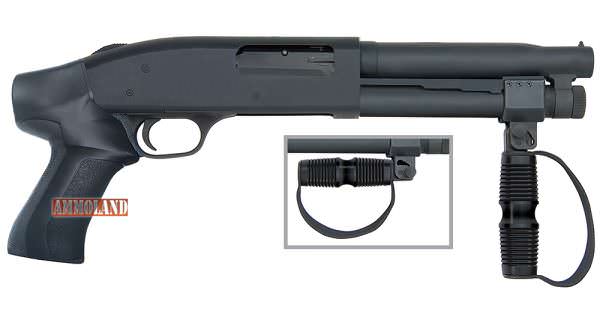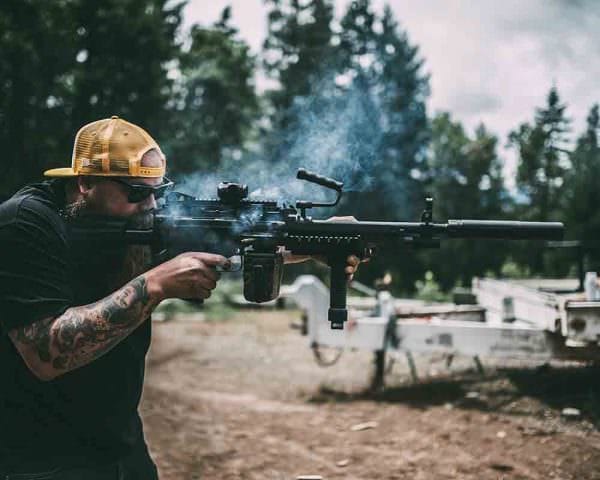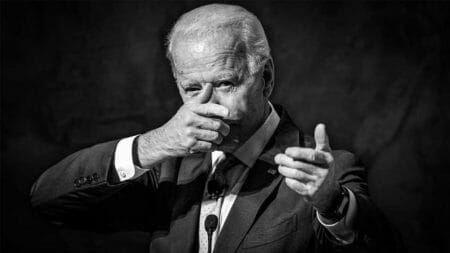

In this first “Myth Busters” article, we address some of the more common misconceptions about the NFA. Be on the lookout for our other Myth Busters articles to be published over the summer.
MYTH #1 – SHORT BARREL RIFLES WITH REGISTERED DROP-IN SEARS MUST BE SEPARATELY REGISTERED
Contrary to this myth, ATF’s longstanding position is that a short barrel rifle (“SBR”) with an installed registered drop-in auto sears do not require separate registration under the NFA. This is because ATF classifies the combined SBR and drop-in sear as a machinegun. In order to be lawfully registered as a machinegun (rather than a registered SBR and registered sear), the drop-in sear and SBR would have to be registered by a qualified manufacturer who reported the manufacture on a Form 2 Notice of Firearms Manufactured or Imported. Alternatively, the sear could be registered by a manufacturer, transferred to a purchaser on a Form 4 Application for Tax Paid Transfer and Registration of Firearm, and installed in a rifle with a barrel of 16 inches or more in length. If the purchaser subsequently wishes to shorten the barrel of the rifle to less than 16 inches in length, no “making” of a firearm takes place, because the combination of the drop-in sear and rifle are a machinegun. However, if the registrant wishes to remove the sear from the rifle, he or she must first submit to ATF a Form 1 Application to Make and Register a Firearm for approval. Only after the Form 1 is approved may the sear be removed. This will result in both the sear and the short barrel rifle being separately registered.
Collectors who acquire drop-in sear/SBR combinations that are registered as one machinegun may file a Form 1 to register the SBR separately. This is not required under the statute, but it avoids delay in the event the collector wishes to remove the sear and install it in another rifle. It also eliminates any question whether the sear plus SBR are lawfully registered.

MYTH #2 – THE ONLY WAY TO REMOVE A SHORT BARREL RIFLE OR SHORT BARREL SHOTGUN FROM THE NFA IS TO DESTROY THE FIREARM
Because the barrel is the primary feature that makes these firearms subject to NFA controls, SBRs and SBSs are among the easiest weapons to remove from the NFA by eliminating or modifying the barrel. Destruction of the receiver is not required, as long as the firearm does not also shoot automatically. For a NFA-qualfied manufacturer (a Type 07 or Type 10 Federal Firearms License holder and Special (Occupational) Taxpayer), the barrel must be stored separately from the rest of the rifle or shotgun parts. For any person other than a NFA – qualified manufacturer, however, it is not sufficient to just remove the barrel. If the barrel and remainder of the parts remain under the custody and control of the same person, that person may be in possession of a short barrel rifle or short barrel shotgun. The barrel should either be destroyed or transferred to another person. A barrel of 16 inches or more may then be attached to the rifle, or in the case of a shotgun, a barrel of 18 inches or more. This will result in both types of firearm being subject only to the Gun Control Act (GCA) and not the NFA.
MYTH #3 – ALL PISTOL GRIP SMOOTH BORE FIREARMS ARE REGULATED AS “ANY OTHER WEAPONS” (AOW)
A pistol grip smooth bore firearm is regulated as an AOW only if its overall length is less than 26 inches.
The NFA defines the term “any other weapon” to include (1) any weapon or device capable of being concealed on the person from which a shot can be discharged through the energy of an explosive; (2) a pistol or revolver having a barrel with a smooth bore designed or redesigned to fire a fixed shotgun shell; and (3) weapons with combination shotgun and rifle barrels 12 inches or more, less than 18 inches in length, from which only a single discharge can be made from either barrel without manual reloading.
It is clear that pistol grip smooth bore weapons do not fit within categories (2) or (3). For Category (1), ATF’s internal standard for determining whether a weapon is “capable of being concealed on the person” is that the firearm is less than 26 inches in length. Accordingly, unless the overall length of a pistol grip smooth bore weapon is less than 26 inches, the firearm does not fit within this category. Collector-type firearms within this category include the H&R Handygun, the Ithaca Auto and Burglar Gun, and the Stevens Tip-Up Pistol. All have an overall length of less than 26 inches.

MYTH #4 – NFA FIREARMS TEMPORARILY IMPORTED INTO THE UNITED STATES UNDER STATE DEPARTMENT LICENSE ARE NOT SUBJECT TO THE NFA
Under the Arms Export Control Act, the Department of State regulates the temporary importation and export of defense articles, including certain types of firearms pursuant to the International Traffic in Arms Regulations (ITAR). However, firearms temporarily imported into the United States are also subject to ATF controls and restrictions implemented under the GCA and the NFA. This is because both statutes control “imports” of firearms, with no distinction between temporary and permanent importation.
In a ruling issued in 2004, ATF made it clear that compliance with the temporary import provisions of the ITAR does not excuse an importer from compliance with the import provisions of the GCA and NFA. In ATF Rul. 2004-2 ATF held that importers temporarily importing NFA firearms on a temporary import license (DSP-61) must register the firearms with ATF by submitting ATF Form 2. Although ATF Rul. 2004-2 was modified, in part, by ATF Rul. 2014-1, ATF continues to take the position that firearms temporarily imported on a DSP-61 must be registered on Form 2. Although not specifically required by the 2004 ruling, a Form 9 Application and Permit for Permanent Export of Firearms should be obtained. This will ensure the re-export of the firearm is recorded in the National Firearms Registration and Transfer Record.
MYTH #5 – SILENCERS MAY BE REPAIRED WITHOUT NOTIFICATION TO ATF
ATF takes the position that worn or damaged components in a registered silencer may be replaced by a person licensed under the GCA and who has paid special (occupational) tax. However, there are important exceptions to this general rule, as follows:
- If the marked component (i.e., the outer tube) of the silencer must be replaced, this amounts to the making of a new and different silencer. The new silencer must be marked, registered, and transferred in accordance with the NFA and GCA.
- If identical replacement parts are not available and the new parts increase the length of the outer tube, this also amounts to a making of a silencer that must be marked, registered, and transferred in accordance with the GCA and NFA.
- If repairs change the diameter or caliber of a silencer, this is also the making of a new silencer that must be marked, registered, and transferred in accordance with the NFA and GCA.

MYTH #6 – TEMPORARY TRANSFERS OF NFA FIREARMS TO WRITERS AND EVALUATORS DO NOT REQUIRE ATF PERMISSION
ATF Rul. 2010-1 overruled a 1969 ruling and a 1972 Industry Circular that held that temporary assignments of firearms to employees, agents, and representatives of a FFL are not “transfers” subject to the requirements of the GCA. ATF Rul. 2010-1 addressed temporary transfers of firearms to unlicensed employees for bona fide business purposes and to other non-employees, such as contractors, writers, and evaluators. The ruling makes it clear that no transfer under the GCA occurs as long as the FFL’s assignment of an inventory firearm is for a limited period of time, where title and control of the firearm remain with the FFL, and the assignment is to a bona fide employee for business purposes of the FFL. In all other instances, including temporary assignment to contractors, technical writers and evaluators, ATF made it clear that disposition of the firearm must be accomplished through completion of ATF Form 4473, compliance with the Brady Law, and all other requirements of the GCA.
ATF Rul. 2010-1 did not address transfers under the NFA. However, given the broad definition of “transfer” in the statute and agency practice, it is apparent the same rationale applies. Accordingly, the only way a lawful transfer to a contractor, writer, or evaluator can occur is with an approved ATF transfer form.
MYTH #7 – MACHINEGUNS MAY BE TRANSFERRED TO PRIVATE SECURITY COMPANIES IF THEY HAVE A GOVERNMENT CONTRACT
Machineguns are subject to restrictions under the GCA and NFA. Government agencies acquiring firearms for official use are generally exempt from all or most of the requirements of both statutes. However, private companies holding contracts with a federal, state, or local government agency do not stand in the shoes of the agency for purposes of such exemptions. Accordingly, transfers of machineguns to private security companies must comply with all provisions of the GCA and NFA.
However, ATF will approve transfers of machineguns to private security companies if they hold contracts to provide security at nuclear facilities licensed by the Nuclear Regulatory Commission. A 2005 amendment to the Atomic Energy Act of 1954 was necessary to carve out this exception to ATF’s general rule on contractors.

MYTH #8 – MACHINEGUN SALES SAMPLES MAY BE ACQUIRED FOR DEMONSTRATION TO FOREIGN GOVERNMENT AGENCIES
ATF regulations on machinegun sales samples allow acquisition of such samples by FFLs for demonstration to federal, state, or local government agencies. ATF requires a “law letter” to be submitted with the transfer application for dealer sales samples. The letter must be from a federal, state, or local government agency expressing an interest in a demonstration of a particular model of machinegun. The National Firearms Act Division will not approve a transfer when the law letter submitted is from a foreign government agency.
However, machinegun sales samples lawfully acquired pursuant to a law letter from a federal, state, or local government agency and that are actually used in a demonstration to such an agency may thereafter be used for demonstrations to foreign government agencies. ATF advises that as long as the registrant maintains continuous custody and control over the firearms during the demonstration there would be no violation of the law.
The above alert is for informational purposes only and is not intended to be construed or used as legal advice. Receipt of this alert does not establish, in and of itself, an attorney-client relationship.
About Reeves & Dola
Reeves & Dola is a Washington, DC law firm that specializes in helping clients navigate the highly regulated and complex world of manufacturing, sales and international trade of defense and commercial products. We have a deep understanding of the Federal regulatory process, and use our expertise in working with a variety of Federal agencies to assist our clients with their transactional and regulatory needs.





Best Answer: REPEAL NFA AND GCA!!!!!!!
Agreed! How many fully automatic weapons have been used in the commission of a crime lately? NONE! Not since the days before The NFA!
I need a lawyer to translate some of that for me. These laws are deliberately complex to make it difficult for the layman to understand.
I enjoy your articles very much. Keep it up keep sending this is one e mail I don’t mind recieving.
“A well regulated militia being necessary to the security of a free state, the right of the people to keep and bare arm shall not be infringed.” Codified law since 1789.
And there you have it hippy…THAT is the only misconception about the NFA. Apparently the author doesn’t understand that the NFA is unconstitutional “legislation” and is in no way, shape, or form “law.”
“If the word law has ever meant one thing more than another, that thing has been the will of those in power.” – Josiah Warren
@Bob, You and hippy are correct, but District of Corruption law firms are making tons of money supporting this law and the BATFE. Those guys are exactly who take away our freedoms for their own profit.
@Bob M and hippy, Here is another NFA myth: it solves crime.
The NFA was never meant to solve crime, but rather to reduce it.
Obviously, it failed miserably.
@Big Bill, Isn’t reducing crime a solution? Let’s not split the hair too fine, brother. It did fail, and it is time to repeal the NFA.